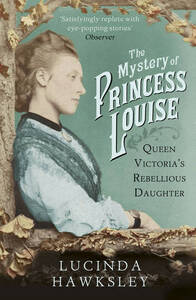
If someone had thought to ask Queen Victoria what sort of daughter she didn’t want, she might have described Princess Louise: a smoker, a cyclist, and a strong-minded feminist who consorted with the likes of Josephine Butler and George Eliot. It is this tense mother-daughter relationship that dominates Lucinda Hawksley’s lively and enjoyable biography of an intriguing royal whose attitude to sex was distinctly unvictorian.
Writing in her journal on the occasion of Louise’s 1st birthday, Queen Victoria commented “May God bless the dear little child, who is so fat, strong and well again. She was born in the most eventful times, & ought to be something peculiar in consequence.” Louise entered the world in 1848, a year when Europe was in the grip of revolution and London was overrun with irate Chartists. Victoria, with good reason, feared for her life and the safe delivery of a baby girl came as a huge relief. As the sixth child of Victoria and Albert, Louise had a lot of competition for attention, even before three further siblings arrived. She felt stifled by a court life that offered few outlets for her considerable artistic talents.
Queen Victoria’s parenting skills have been impugned on many occasions and Hawksley is keen to join the chorus of disapproval. This is disappointing. While Hawksley cites Yvonne Ward’s recent book Censoring Queen Victoria, which explains how the queen’s journals and letters were heavily edited, she blames all of Louise’s early misfortunes on Victoria, based on ‘evidence’ from these very documents. Albert is entirely let off the hook, notwithstanding many accounts of his harsh discipline and unforgiving nature. To my mind, Victoria was a despot married to a fusspot, and they were equally complicit in the upbringing of their oldest children. In the second half of the biography, covering the years after Victoria’s death in 1901, the real Louise emerges – her faults and errors shown as part of her complex and engaging personality, rather than as a reaction to her unreasonable mother. She is urbane, vituperative, and glamorous, maintaining a strict diet and exercise regime to avoid turning into a Hanoverian Weeble.
Like many nineteenth-century mothers, Victoria’s approach to dealing with her rebellious daughter was to find her a husband. The trouble was that Europe was fast running out of eligible princes and, in any case, the British people had little appetite for foreigners. The queen had to settle for Louise marrying a commoner, albeit a Marquess whose father was the 8th Duke of Argyll. At first sight, the Marquess of Lorne seems an ideal match for Louise: he was handsome, intelligent, and shared her belief in women’s rights. However, he was described by one contemporary as “not overfond of soap and water” and his lack of dress sense proved a perpetual source of humiliation for his wife. More importantly, he was homosexual. Whereas previous biographers have been tediously equivocal over Lorne’s sexuality, Hawksley uses common sense and deftly refutes the specious ‘proof’ that he loved the ladies. When the couple lived at Kensington Palace, rumours circulated that Louise had the French windows bricked up to prevent Lorne sneaking out for late-night assignations with guardsmen.
The central ‘mystery’ indicated by the book’s title is Hawksley’s contention that the 18-year-old Louise gave birth to an illegitimate son, Henry, who was later adopted by Queen Victoria’s obstetrician, Sir Charles Locock. The father, she claims, was Walter Stirling, tutor to Prince Leopold, Louise’s haemophiliac brother. While the story is plausible, there is no evidence. The current Locock family, who believe themselves to be descended from the Princess, have been repeatedly denied a DNA test; Hawksley, meanwhile, has been refused access to the Royal Archives. Less contentious is Hawksley’s belief that Louise had an affair with the sculptor Edgar Boehm, who had been a great friend and mentor. When Boehm died of a stroke at his London studio, Louise was with him. Rumours abounded that he died ‘on the job’ (think Mr Pamuk in Downton Abbey) and had to be smuggled out, Cleopatra style, in a rolled-up carpet.
We’ll probably never know the truth about this incident or whether Louise really did have a baby out of wedlock. The Royal Archives and the keepers of Lorne’s papers are all determined that the truth should be suppressed. Even the National Gallery’s files on Boehm have been closed. Hawksley’s evidence for her more scandalous claims is thin, but speculation is inevitable when the facts are guarded by unyielding custodians. Other biographers have been allowed to view the Princess Louise files, but have been obliged to submit their manuscripts for inspection before publication. Consequently, Jehanne Wake’s otherwise excellent Princess Louise: Queen Victoria’s Unconventional Daughter portrays an unconvincing paragon of virtue, and Elizabeth Longford’s Darling Loosy: Letters to Princess Louise is frustratingly cryptic.
As Hawksley writes, “Over the decades, there has been some very careful sanitising of Princess Louise’s reputation and a whitewashing of her life, her achievements and her personality.” Why this has happened is unclear, although the sexual double standard is a likely explanation. While older brother Bertie, later Edward VII, was a playboy who inevitably sowed his wild oats, the thought of a princess doing the same was unconscionable. But now, almost 150 years later, we can tolerate the truth. In conclusion, Hawksley asks, “Why should the life of a woman born in the first half of the nineteenth century be considered unsafe to be explored in the twenty first century?” Why indeed.
The Mystery of Princess Louise: Queen Victoria’s Rebellious Daughter by Lucinda Hawksley